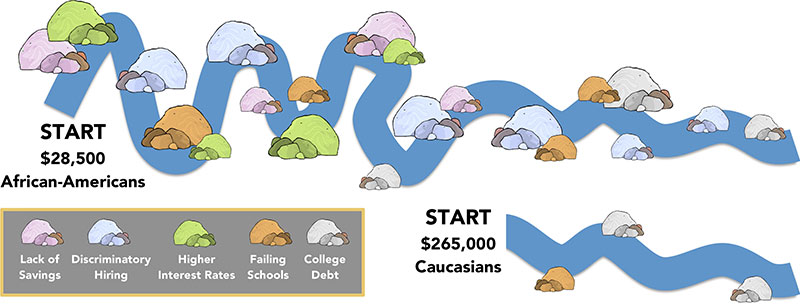Lack of Capital
Lack of capital makes it exponentially more difficult to climb the economic ladder out of poverty. This is a problem for all poor Americans, but ethnic minorities in the U.S. have historically had even less access to wealth than Caucasians.
Imagine running a race where half of your fellow racers get to start a hundred yards ahead of where you line up. You might be very fast, but it will be very difficult to catch the racers who started far ahead of you. Now imagine that while you’re trying to catch up, you keep running up against obstacles in your way, obstacles that the folks farther ahead either encounter at significantly smaller rates or do not encounter at all.

Two examples will help illustrate. Both contemporary and historical issues such as immigration and slavery have resulted in a massive head start for the white majority in the United States. Many immigrants have sought freedom and work in the “land of opportunity,” heeding our call proclaimed on the Statue of Liberty to “Give me your tired, your poor, your huddled masses yearning to breathe free.” Arriving poor, they often stay poor.
Slavery in the U.S. paints a similar picture in terms of a delayed start and restricted access to opportunity. One of the results is that median net worth of Caucasian families in the US is $265,000, nine times more than the median net worth of African American families at $28,500.[1] One reason for this disparity is historical wealth accumulation: Caucasian families have had more time to save money through the generations. When Caucasian and Black families start off with a similar amount of wealth, their wealth accumulation is fairly similar ($5.19 per $1 income increase for Caucasians, $4.03 for African Americans).2 Just by starting African American and Caucasian families at the same financial starting line goes a long way in erasing the difference between the two groups in terms of financial success.
But of course most Black families do not start off where white families do, so the reality is far different. And financial starting lines don’t explain everything. The financial gap—$5.19 compared to $4.03—makes it clear that there are additional inequalities facing African American men and women in the U.S., making it difficult for them to succeed. These are the obstacles thrown onto the track mentioned earlier. They include the higher cost of not having capital, the inability to build savings from inheritances, and inequalities in education and employment.
Sources [1] Rakesh, Kochhar, Richard Fry and Paul Taylor, Wealth Gaps Rise to Record Highs Between Whites, Blacks, Hispanics. Pew Research Center, July 2011. Data is from the Survey on Income and Program Participation. Review 99, no. 2 (2009): 41-44. 2 Shapiro, Thomas, Tatjana Meschede, and Sam Osoro. 2013. The Roots of the Widening Racial Wealth Gap: Explaining the Black-White Economic Divide. Research and Policy Brief: Institute on Assets and Social Policy, February:1-7; citing pages 4-5. Online: iasp.brandeis.edu/pdfs/Author/shapiro-thomas-m/racialwealthgapbrief.pdf

